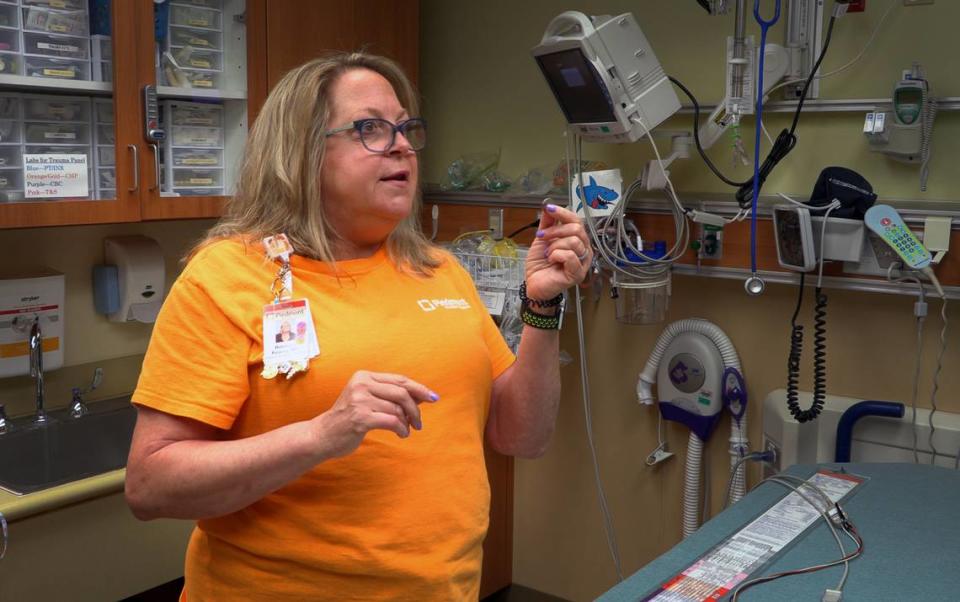A hidden menace: Columbus toddler’s death spotlights button battery poison risk to children
The father shed tears remembering the dreams he had for his son.
His son Nicholas Alexander “Alex” Clinkscales II was 15 months old when he died from a button battery that lodged in his esophagus and burned through the tissue.
The boy’s father testified last month in a lawsuit against the child’s Columbus pediatrician, alleging she misdiagnosed him by not suspecting a foreign object.
Taking the witness stand in Muscogee State Court, Nicholas Clinkscales said he had looked forward to teaching his son to play baseball, like his dad.
“I was in the process of teaching him how to catch,” said the father, who once had a good arm, before separating his shoulder: “I could throw a ball through a shower and not get it wet.”
He also had imagined teaching the boy math: “I didn’t have anybody to teach me math. I had to figure that out on my own,” he said.
He did not know when or where the toddler got the button battery, only that after three visits for medical treatment, the boy was rushed to the emergency room with blood gushing from his mouth, and died there.
His parents were grief-stricken, their dreams for their son broken.
The jury awarded them $4 million.
The danger
Nicholas and Shameka Clinkscales’ son died in the emergency room on Nov. 19, 2014. The lawsuit claimed he likely ingested the coin-sized battery as early as Nov. 1, though an expert for the defense disputed that.
Neither side in the court case disputed the danger button batteries pose to children. Around 3,000 children on average swallow them each year in the United States. Piedmont Columbus Regional has reported three battery ingestions in the past year, according to its pediatric emergency department.
A study published in the journal Pediatrics in August 2022 found that 12% of children swallowing batteries had to be admitted to the hospital, after being taken to the emergency room, and that battery ingestions had doubled over a decade.
From 2010-2019, a child with a battery-related injury showed up at a U.S. emergency room every 75 minutes, on average, twice the frequency reported in the years 1990-2009, the research showed, and 85% of the cases involved button batteries.

Most of the children swallowing batteries are five years old or younger.
“Many times they’re just hand to mouth,” said Pam Fair of the nonprofit Safe Kids Columbus, a chapter of Safe Kids Worldwide, which aims to prevent accidental childhood injuries. “They’re going to explore with their mouths. That’s just what they do.”
Button batteries power multiple devices: TV remote controls, singing greeting cards, key fobs, flameless candles, hearing aids, bathroom scales, and novelty jewelry that lights up.
In some gadgets, they’re easily dislodged. Lithium batteries about the size of a nickel, marked CR2025, CR2032, CR2330 or CR3032, can block a child’s esophagus, if swallowed, and then react to body fluids.
“When the battery is stuck in the esophagus, it creates a current, so it burns the tissue,” said Dr. Rebecca Reamy, chief of pediatrics and medical director of the pediatric emergency department at Piedmont Columbus Regional. “It creates a chemical reaction to the mucous membrane, which is the lining of the esophagus and also the lining in the nose, and that creates tissue breakdown.”
It can be fatal because of the location.
“The esophagus sits right in front of the aorta, and so it can burn through the esophagus into the aorta, which is the biggest artery in the body, and the child can literally bleed to death in seconds,” she said.
Even after the coin’s removed, damaged tissue may come apart, she said, noting a girl in South Carolina died after the extraction. “The problem is at that point, there’s nothing you can do,” she said.
If their esophagus is separated, children who survive the ordeal need a feeding tube to the stomach, said Fair: “Your esophagus doesn’t lead food to your stomach anymore.”
If the battery passes through the esophagus, it may stick at the opening to the stomach, another tight space, Reamy said.
“If it makes it through that muscle, it’s usually going to pass the rest of the way on its own,” she said. Doctors will monitor its progress to be sure it does not stick in the intestine, she said.
The three-volt battery that typically sticks may look like a coin, but an X-ray clearly shows the groove around its edge, Reamy said, so it’s easily distinguished.
Doctors have a device for retrieving it through the throat.
“They go in with a scope that’s got a little camera and grabbers on it, so they grab it and pull it out, and then they can see how everything looks down there,” Reamy said.

How long do you have?
Despite the damage they do, button batteries may not instantly produce signs of distress, particularly used batteries that have lost much of their charge.
The symptoms, such as sore or red throat, difficulty swallowing, not eating, vomiting or drooling, may appear to be an infection or other ailment.
“It’s tricky because it’s coughing, drooling and discomfort,” said Fair. “That could be they’re getting their teeth in. It could be so many things.”
The Clinkscales sued Dr. Susan Ellen McWhirter and Rivertown Pediatrics, claiming she should have suspected a button battery when she examined their son on Nov. 6, 2014.
The suit alleged he likely swallowed the battery on Nov. 1, when he threw up. He was taken to urgent care that day, diagnosed with pharyngitis, and prescribed an antibiotic.
His parents took him to Rivertown Pediatrics on Nov. 4, when he saw another doctor who still thought he had acute pharyngitis and a viral infection.
During his next visit two days later, McWhirter also suspected a viral infection, and prescribed another antibiotic. Her diagnosis was consistent with the symptoms she saw and what she knew of his previous exams, she testified in court.
“Kids that have infections are sick typically for a couple of weeks,” she said.
Had she suspected a button battery, she would have sent him to the hospital right away, she said: “If you even think they might have swallowed a battery, you go to the emergency room.”
That warning’s repeated in all sources on battery ingestion: The child must go to the emergency room immediately, even if the caregiver only suspects a button battery was swallowed.
Even if you suspect, you cannot wait, you must go ahead and find out.... Time’s ticking,” Fair said. “The last thing you want to happen is for it to sever that esophagus.”
Parents should not try to make the child throw up or wash the battery down, said Fair. If they want immediate advice, they may call the National Button Battery Ingestion Hotline at 1-800-498-8666.
Online warnings say the battery can cause damage within two hours. A defense expert testified during the Clinkscales trial that the reaction can start in five or 10 minutes.
The expert was Dr. Ian Jacobs, of the Childrens Hospital of Philadelphia. He doubted the boy swallowed the battery weeks before his death. “I think this was a short-term ingestion,” said Jacobs. He thought it was within a day or two of the child’s death, he said, though he acknowledged that long-term battery blockages are possible.
What to do
Keeping track of button batteries is crucial.
“The main thing is just to be aware of where they are, and to try to keep your children from playing with those things,” said Fair. “Don’t make it a habit of letting your child play with the TV remote.”
Stowe batteries where kids can’t find them, and keep count of them, to ensure none go missing, she said. If a button battery’s in a device that’s regularly used, like a TV remote, secure the battery compartment with some duct tape, and check other gadgets that may have one.
Manufacturers are more securely packaging the batteries for retail sales, and adding a coating to give them a bitter taste, she said. But a bad taste may not deter a child.
Fair recalled a patient who ate powdered kitchen cleaner, because the green can looked like a Parmesan cheese dispenser, and the contents shook out the same.
“The child I think said to the parent, ‘Mommy, I don’t like this cheese,’” she said.

She said parents should be cautious of the places their children visit. For example, another poisoning risk is prescription drugs, which older adults may leave sitting out so they remember to take them.
Children may face a poisoning risk wherever they spend time. “That just has to be discussed,” Fair said.
Reamy said children’s toys can have button batteries, though that’s less common now.
“They used to routinely be put in a lot of toys, including stuffed animals that make noise, that kind of thing,” she said. “We don’t allow any toys to be donated that have button batteries in them.”
After the trial
The Ledger-Enquirer asked each side in the button battery lawsuit for comment on the outcome.
McWhirter was represented by the law firm Huff, Powell & Bailey, which on her behalf sent a statement that reads in part:
“We are considering our post-trial options at this time. Regardless of the trial’s outcome, we hope that it brought increased awareness to the dangers of button battery ingestion in children and the severe injuries that can result.”
Though attorney Audrey Tolson of the Tolson Firm, the Clinkscales sent a statement that in part said:
“Before this happened, we had no idea about the dangers of button batteries for children. When Alex suddenly began refusing food and having a hard time swallowing, we did everything we could to advocate for him by taking him to three doctors in five days.... The lawsuit was never about money for our family. We simply wanted to continue to stand for Alex.”
They hope their son’s loss will illustrate the danger of button batteries to other parents and medical providers, they wrote:
“This has been a long and painful fight for our family. Fortunately, we have found strength in knowing that if our willingness to fight could make just one pediatrician pause and think a little bit longer before dismissing a child’s symptoms, or if it could help educate just one parent about the dangers of button batteries and how to protect their own children, then our son’s death was not in vain.”


